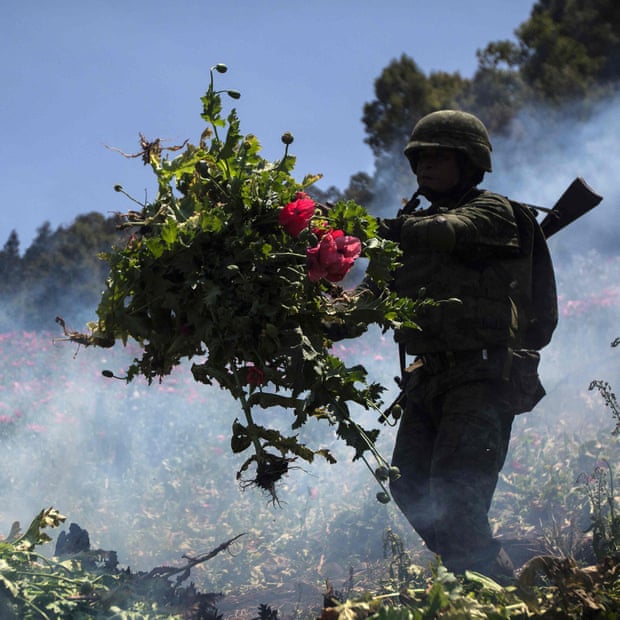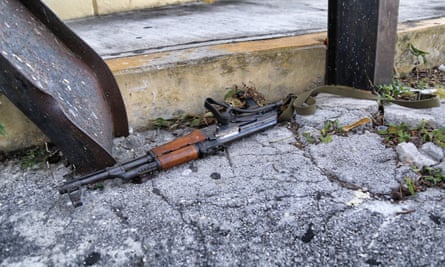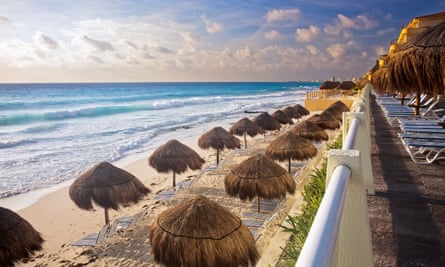The Playamed hospital is an unremarkable two-storey building on a quiet street lined with red-blossomed flame trees, just a few minutes’ drive from the white-sand beaches and all-inclusive resorts of Cancún’s hotel zone.
Recently, however, it was the setting for an incident underlining the relentless spread of Mexico’s drug war to cities previously best known as beach holiday destinations.
Four gunmen burst into a private room at the clinic last week, where they shot dead Alfonso Contreras Espinoza and his wife. Known as “El Poncho”, the murdered man was reputed to be the local boss for the Gulf cartel, and had been released from a local prison to receive treatment for a leg problem.
Investigators discovered a bag of white powder under his leg and a scale, suggesting that Contreras had been dealing from his sickbed.
On a recent morning, hospital officials declined to comment on the brazen attack. Paramedics standing in the shade outside looked away or stared into their smartphones when asked about the incident.
Not so long ago, Cancún sparkled as the crown jewel of Mexico’s Mayan Riviera. But rampant corruption, chaotic development and a string of murders have all tarnished the resort city’s reputation.
Other tourist hotspots have also been caught in Mexico’s red tide: Acapulco, once the country’s most glamorous beach spot, is now the setting for relentless gang violence; late last year, the bodies of six men were left hanging from bridges near Los Cabos on the Baja California peninsula. Earlier this month, a Mexican thinktank named Los Cabos the world’s most dangerous city outside a war zone.
The problems of Mexico’s resort cities mirror those of the country, which last year suffered its most murderous year in memory.
But violence here threatens a key industry: Mexico welcomed nearly 40 million visitors in 2017. Tourism accounts for about 8% of Mexico’s GDP and has long been a ready source of employment for the country’s poor.
Thanks to their strategic locations and transitory populations, Mexico’s tourist destinations have also been prime territory for the country’s criminal groups.
Meanwhile, the government’s strategy of targeting “kingpins” has exacerbated the conflict, as crime groups fracture into rival factions competing for territory and trade.
In Cancún, at least four cartels are thought to be contesting routes to smuggle cocaine in from South America and a local drug market targeting tourists and locals.
Quick GuideMexico's war on drugs
Show

Why did Mexico launch its war on drugs?
On 10 December 2006, Felipe Calderón launched Mexico’s war on drugs by sending 6,500 troops into his home state of Michoacán, where rival cartels were engaged in tit-for-tat massacres.
Calderón declared war eight days after taking power – a move widely seen as an attempt to boost his own legitimacy after a bitterly contested election victory. Within two months, around 20,000 troops were involved in operations.
What has the war cost so far?
The US has donated at least $1.5bn through the Merida Initiative since 2008, while Mexico spent at least $54bn on security and defence between 2007 and 2016. Critics say that this influx of cash has helped create an opaque security industry open to corruption.
But the biggest costs have been human: since 2007, over 250,000 people have been murdered, more than 40,000 reported as disappeared and 26,000 unidentified bodies in morgues across the country. Human rights groups have also detailed a vast rise in human rights abuses including torture, extrajudicial killings and forced disappearances by state security forces.
Peña Nieto claimed to have killed or detained 110 of 122 of his government's most wanted narcos. But his biggest victory – and most embarrassing blunder – was the recapture, escape, another recapture and extradition of Joaquín “El Chapo” Guzmán, leader of the Sinaloa cartel.
Mexico’s decade-long war on drugs would never have been possible without the injection of American cash and military cooperation under the Merida Initiative. The funds have continued to flow despite indisputable evidence of human rights violations.
Under new president Andrés Manuel López Obrador, murder rates are up and a new security force, the Civil Guard, is being deployed onto the streets despite campaign promises to end the drug war.
What has been achieved?
Improved collaboration between the US and Mexico has resulted in numerous high-profile arrests and drug busts. Officials say 25 of the 37 drug traffickers on Calderón’s most-wanted list have been jailed, extradited to the US or killed, although not all of these actions have been independently corroborated.
The biggest victory – and most embarrassing blunder – under Peña Nieto’s leadership was the recapture, escape and another recapture of Joaquín “El Chapo” Guzmán, leader of the Sinaloa cartel.
While the crackdown and capture of kingpins has won praise from the media and US, it has done little to reduce the violence.
Over the past year the upstart Jalisco New Generation cartel (CJNG) has been moving into the resort city, pushing out other groups such as the Gulf cartel.
“[The CJNG] shoot first and ask questions later,” said a source who works on public security issues in Cancún. “These are their methods and they’re now here.”
Political corruption and collusion between politicians and criminal groups is also believed to have exacerbated the problem.
One former governor of the surrounding state of Quintana Roo, Roberto Borge, awaits trial on accusations of graft after being extradited from Panama.
During his 2010-2016 administration, hotel and land owners in Tulum were forced to hand over their properties in complex schemes involving notaries and judges. Journalists who investigated allegations of official wrongdoing were arrested on trumped-up charges.
Mauricio Góngora, the former mayor of Playa del Carmen, just south of Cancún, was arrested after an unsuccessful election campaign to succeed Borge as state governor, and stands accused of misappropriating £9.5m ($13.3m).
“Corruption was escalating and the [Borge] government’s excesses became unsustainable,” said Vicente Carrera, publisher of Noticaribe, an online news outlet in Playa del Carmen. “When the new state government arrived [in late 2016] everything was on its head.”
Amid political turmoil in the state, violence has increasingly encroached on tourist areas, including Playa del Carmen’s fabled Quinta Avenida.

Last week, the US government issued a security warning for Playa del Carmen, and temporarily closed its consulate after receiving information about a “security threat”.
The warning followed an explosion on a tourist ferry, which injured 19 Mexicans and at least five US citizens in Playa del Carmen.
Local authorities said the blast was caused by engine failure, but later investigators said it was caused by explosives. Another device was found on a second ferry, but officials discounted any connection with cartel violence and said tourists had nothing to worry about, although the federal government deployed black-uniformed police and bomb-sniffing dogs to patrol the wharfs and the beach areas.
“The government always wants to downplay the violence,” said Daniel Pérez Villaseñor, a labour lawyer and activist in Cancún.
“The [state] governor doesn’t have a plan for fighting the violence,” he said. “They just want to put some makeup on Cancún to give it a good image.”
Much is riding on that image.
According to Roberto Cintrón, the president of the local hotel association, Cancún airport is receiving a record number of arrivals. Hotel occupancy hovers at 83%.
Cancún was little more than a fishing town when the federal government first bet big on tourism in the early 1970s.
The original plan called for a hotel zone and separate residential area. But as tourism grew, it drew an unexpected influx of migrants from Mexico’s impoverished southern states seeking employment.
They settled on the fringes of the city, where the ramshackle homes and rutted roads feel a world away from the manicured lawns and pricey shops of the hotel zone.
That contrast raises uncomfortable questions about the benefits of tourism.

Wages for workers in the tourism industry are low and benefits scant, while hotel owners pay few taxes and often hire through outsourcing to avoid paying social security contributions, said Pérez.
And while tourists have so far been largely insulated from the violence, the same is not true of residents: a survey in December showed that 84.9% of Cancún’s inhabitants consider the city “unsafe”.
Many outlying neighbourhoods lack basic services. Such neglect has been symbolised by a huge pothole which opened in a busy street 15 years ago and still has not been repaired.
Local residents recently celebrated the anniversary by throwing a birthday party for the flooded hole and installing a 100-meter zip line over the muddy water.
“This is a first world city with third world services,” said José Pech, an electrician who built the zip line.
“The governments we have are the worst. They’re worse than the criminals,” he said. “If they had paid proper attention to the people, if there wasn’t such corruption, organised crime wouldn’t exist as it does now.”
